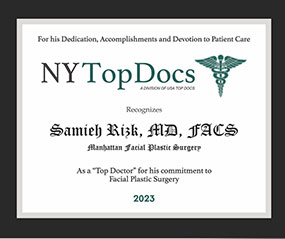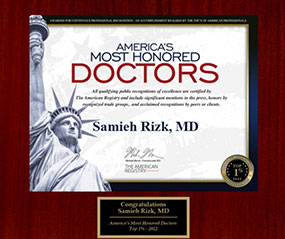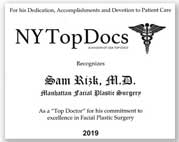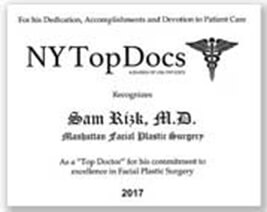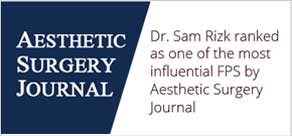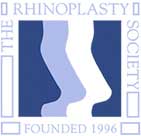What is a deep plane extended facelift?
An extended deep plane facelift lifts all the deeper sagging tissue of face & neck together and does not separate skin from deeper tissue in face which makes it look more natural than a traditional SMAS lift because there is no tension on skin . Also it results in less bleeding and bruising because the blood vessels are under skin layer and by going deeper you save those blood vessels under skin which is important for natural and healthy skin.
These lifts can be also combined with platysmaplasty under chin to tie the loose neck cords made of of sagging platysma muscle.
Does Dr Rizk use drains?
Dr. Rizk does not use drains. He published peer reviewed articles and books that drains are more painful, increase infection and cause more scarring and blood vessel breakage under skin and don’t prevent hematoma. Instead he uses tissue glues internally which reduce fluid and blood and reduce bruising and allow a faster recovery.
What is a facelift?
A facelift describes a surgical procedure which rejuvenates the face and neck. It does not address the eyes and brows, which require different procedures called blepharoplasty (eye lift) or brow lift. A facelift should address not only the skin, but the loose muscles and drooping fat in the face in order to last a long time and to look natural. Sometimes a facelift is combined with other rejuvenation procedures such as laser skin resurfacing to improve skin texture and superficial wrinkles, or it may be combined with a brow lift or eye lift for total facial rejuvenation. A facelift will not stop the aging process, but can make you look naturally younger than your stated age.
How long does a facelift procedure take?
A facelift typically takes 2-4 hours, depending on the complexity and extent of surgery. Your surgeon will discuss the expected length of your procedure with you during your consultation.
What kind of results should I expect from a facelift?
Results of a facelift vary depending on the individual and the extent of surgery. Generally, you can expect to look more youthful and rested with a more contoured jawline, improved neck contours, tighter skin on the face, and fewer wrinkles and lines. Take a look at the facelift before and after photos from Dr. Rizk’s patients.
Is facelift surgery painful?
Most patients report only minimal discomfort during and after facelift surgery. Anesthesia is administered during the procedure to help minimize any pain or discomfort. Your surgeon will discuss pain management options with you before your procedure.
How much does a facelift cost?
The cost of a facelift can vary depending on the extent of surgery and other factors such as geographical location. Your surgeon can provide an estimate of the cost during your consultation. Schedule your consultation with Dr. Rizk, New York’s most respected facelift surgeon.
What are the different types of facelifts available?
The two most commonly performed types of facelifts are a traditional facelift, a deep-plane facelift and a mini-facelift. A traditional facelift addresses sagging skin and wrinkles in the cheeks, chin, jowls, and neck. A deep plane facelift, which Dr. Rizk performs, targets the deepest layers of the skin. A mini-facelift is less extensive than a traditional facelift and is used to target wrinkles and sagging in the lower half of the face. In some cases, a combination of both procedures may be recommended. Your surgeon will discuss which type of facelift is best for you during your consultation.
Is a facelift permanent?
Results of a facelift can last for many years, but will not stop the natural aging process. To maintain your results, it is important to follow a healthy lifestyle, including eating a balanced diet and avoiding sun exposure. With proper care, you can enjoy your facelift results for many years.
Is a facelift safe?
A facelift is generally considered safe when performed by a board-certified plastic surgeon. However, as with any surgery, there are certain risks and side effects associated with facelift surgery. Before undergoing the procedure, your surgeon will discuss the risks with you in detail. It is important to follow all of your surgeon’s pre- and postoperative instructions to reduce the risk of complications and ensure the best results possible.
What are the benefits of getting a facelift?
The benefits of a facelift include improved facial contours, reduced wrinkles and lines, tighter skin on the face, and a more youthful overall appearance. In addition, facelift surgery can restore self-confidence and have a positive effect on your overall quality of life.
What should I do to prepare for a facelift procedure?
Your surgeon will provide you with specific instructions on how to prepare for your facelift. In general, it is important to stop smoking and drinking alcohol for at least two weeks before your procedure, and to avoid taking certain medications or supplements that can increase bleeding risk. You should also arrange for someone to drive you home after your facelift surgery. Your surgeon will provide additional instructions during your consultation.
What are the non-surgical facelift options?
A facelift is a surgical procedure. Non-surgical rejuvenation treatments are sometimes labeled as “facelifts”, but they are not. Non-surgical treatments such as fillers or Botox may help delay the time at which a facelift is performed and may be used in conjunction with a facelift to achieve long-lasting results. Fillers and Botox cannot improve a sagging neck or jowl, but can improve forehead frown lines or crows feet lines around the eyes or a deep nasolabial fold. Fillers may also be used to plump up the lips or cheeks and can usually be used in addition to a facelift.
What should I expect during my pre-operative and post-operative visits?
Your surgeon will review any pre-operative instructions with you during your initial consultation. During the pre-operative visit, your doctor will discuss the procedure in detail and answer any questions you may have. After your facelift, you will be seen for post-operative visits to monitor your recovery and address any concerns. During these visits, your surgeon may provide additional instructions or treatments to help optimize your results.
Are there any lifestyle changes I should make after having a facelift?
Yes, it is important to follow a healthy lifestyle after your facelift procedure. This includes eating a balanced diet, avoiding smoking and alcohol, using sunscreen when outdoors, and avoiding strenuous activities for several weeks after the surgery. Light exercise is only recommended after a few weeks. Your surgeon will provide specific instructions on what to do (and not do) after your procedure. Following a healthy lifestyle can help maintain the results of your facelift for many years.
It is also important to keep follow-up appointments with your surgeon. These visits are a great opportunity for you to discuss any worries or questions that may have arisen since your procedure. Your surgeon will be able to provide additional guidance or treatments if needed. Following these recommendations can help you enjoy the results of your facelift for many years to come.
Is there any maintenance required after a facelift procedure?
Yes, there are several steps you can take to ensure the results of your facelift remain long-lasting. This includes continuing a healthy lifestyle, using sunscreen when outdoors, and avoiding exposure to extreme temperatures. Additionally, you may want to consider non-invasive or non-surgical procedures such as laser treatments or chemical peels to help maintain the results of your facelift. If you have any questions or concerns, be sure to speak with your surgeon. They will be able to provide additional guidance and advice.
When will I be able to see the results of my facelift?
The full results of a facelift may not be visible until several weeks after the procedure. Swelling and bruising typically take several weeks to completely resolve, so it can take up to 6 months for the final results of your facelift to be visible. During this time, your surgeon may provide additional treatment or guidance to help optimize your results. It is important to be patient during the recovery process as your body adjusts to the changes that occurred during surgery.
How do I choose a qualified surgeon?
It is important to understand the difference between a board certified facial plastic surgeon (www.abfprs.org) and a general plastic surgeon. The facial plastic surgeon specializes in only facial plastic surgery including the face, neck, nose and eyes. The general plastic surgeon does breast and body plastic surgery as well as hand surgery and facial plastic surgery. Facial plastic surgeons spend much more time in their training studying and operating on the face and neck than general plastic surgeons who train in general surgery. Facial plastic surgeons understand the deep facial and neck anatomy to a greater extent than general plastic surgeons. Dr. Rizk is a double board certified facial plastic surgeon who has pioneered his own facelift and necklift techniques. Click here to read articles published by Dr. Rizk on the latest advances on facelift and neck lift surgery.
How do I know if I am a good candidate for a facelift?
The best candidate for a facelift is a person whose facial skin has sagged and who has sagging of the jowls and neck. A strong, well defined bone structure is important for a good result. If the bone structure is weak or the patient has a small chin, a chin implant or cheek implant may be necessary. If the patient has a very thin face, fat injections may be necessary at the same time to replenish lost facial volume with the aging process. You are a good candidate for facelift if your weight is stable, are medically cleared for the surgery, and do not smoke. A patient has to also have a positive outlook and have realistic goals for improvement in appearance.
How long does a facelift last?
The results vary from person to person, depending on individual skin elasticity, skin tone, history of sun exposure or smoking, etc. However, most people can expect the results to last 8-10 years. Even after these 8-10 years, the patient will still look better than if they did not undergo the procedure. Another procedure may be required in 10 years.
What anesthesia is given during a facelift?
A facelift may be performed under sedation anesthesia or general anesthesia depending on patient preference. Patients will require blood work, tests and a medical clearance prior to undergoing a facelift operation. Dr. Rizk, a New York City based facial plastic surgeon, puts his patients’ safety first and a facelift is a very safe procedure done on appropriate candidates who have been selected carefully and medically cleared.
If I am overweight, should I wait to lose weight before having a lift?
If you are significantly overweight, you should lose that weight before considering the procedure. Our doctor also sees many patients who have undergone gastric bypass surgery and have lost a significant amount of weight, resulting in their neck sagging significantly due to their weight loss.
What are the different types of facelift surgery available?
All techniques for facelift surgery need to be customized to each patient. There are many techniques for partial versus full facelifts. Some partial lifts include only the neck if the neck is the only sagging area, as seen in some younger patients. Some lifts address the lower face and neck areas only, some address the midface and some address the midface, lower face and neck. Male facelifts are different and focus mainly on the neck and lower face. In facelifts, the best lifts address different structures that age deeper in the face, including the loose muscles and fat pads in the face. Skin facelifts alone do not look natural and do not provide longevity. SMAS lifts address the muscles that age in the face and neck. Deep plane facelifts address the loose muscles that age and the fat pads that droop to form the jowls in the face. Mini facelifts may occasionally be needed if there is only skin which is drooping. Dr. Rizk, a New York based double board certified facial plastic surgeon has pioneered the use of various 3D telescopes to assist in visualizing the internal facial structures through smaller incisions around the ear. This technology is similar to the advent of high definition flat screen TVs versus older television sets. Dr. Rizk teaches instructional courses on the use of this technology to advance facelift surgery into a more precise operation. With Dr. Rizk’s rapid recovery techniques, you could look presentable in public in just one week. Weekend facelifts, as advertised are usually either not true facelifts or facelifts that lift only skin. Liquid facelifts are another type of media hyped term, but is not a true facelift – rather, is filling the face with fillers.
Does a facelift tighten the muscle?
Dr. Rizk, a New York City based facial Plastic Surgeon, believes in tightening not only the loose muscles beneath the skin, but also the loose and drooping fat pads in the face which form the jowls and turkey neck. Repositioning the fat pads and tightening the muscles are important components in doing a natural facelift which lasts a long time. If the muscles are not tightened, because of the elasticity of the skin, the face will droop again within 6 weeks. Successful facelift surgery involves tightening the loose muscles, lifting the fat pads and excising the redundant skin. Thread lifts fail because they do not involve skin excisions and are a blind procedure done without a good view of where the deep sutures are placed and can cause deep tissue damage.
I don’t want to look “pulled” or “too tight” but I want a dramatic change
All of Dr. Rizk’s patients look natural because he does not tighten just the skin and does not do thread lifts which make patients look stretched or pulled. Dr. Rizk tightens beneath the muscle and jowls, not just under the skin, and the excess skin is removed once the deeper structures are tightened. This also provides longevity to the procedure. Most patients tell us that their friends make comments like, “You look refreshed, like you got a nice haircut or have been on a vacation.” This does not mean that the results are not dramatic. A patient could get a dramatic result and a natural result at the same time. Not all results will be dramatic because this depends on what each individual patient starts with. Younger patients may have less dramatic results due to their age, but older patients will have more dramatic results. The key to a great facelift, according to Dr. Rizk, is to preserve the features of the face that are unique to a person.
How does male facelift surgery differ?
Male patients are mainly interested in their necks and lower faces and are rarely interested in or need a complete facelift, and according to Dr. Rizk, his list is composed of 30% male patients. Male patients have thicker skin and a beard, which requires modification of the facelift incisions. Male patients also get a better result in their necks with an additional procedure called midline platysmaplasty, where the muscles are sutured together in the middle of the neck while visualizing them with a 3D high definition telescope. Dr. Rizk does this midline platysma muscle binding in the neck with most male patients to achieve a superior result.
Does a facelift get rid of my wrinkles?
The deeper wrinkles created by laxity of the skin and muscles will improve after a facelift, but the finer superficial wrinkles do not improve with a facelift. Finer skin wrinkles may require treatments like Botox, or an adjunctive laser skin resurfacing procedure to improve the more superficial skin wrinkles and improve and rejuvenate skin texture.
Can I have a facelift if I smoke?
Smoking affects healing in a negative way. If you are an active smoker, you would need to stop smoking for at least 2 weeks before surgery and at least 2 weeks after surgery. Dr. Rizk recommends to stop smoking altogether, as smoking also makes the face age faster by absorbing collagen and destroying the blood vessels which nourish the skin. A deep plane facelift is preferred in patients with a history of smoking so as not to further interrupt the blood vessels going to the skin.
How long does it take before I can resume regular activity after my facelift?
A few weeks is usually necessary depending on the amount of work done before returning to work or normal activity. Avoiding strenuous activity is recommended for 2 weeks after the surgery and avoiding sun exposure is recommended for at least 6 weeks after the facelift. Wearing sunblock is recommended if sun exposure is expected for any reason. Out of town patients who travel to New York for surgery cannot travel back to their home state or country for at least 1 week following the surgery.
Can a facelift be done with other facial cosmetic procedures?
A facelift can be performed with a brow lift, eye lift, chin or cheek implant or nose job, or it can be performed as an isolated procedure. Laser skin resurfacing can also be done at the same time to improve superficial skin wrinkles or sun or smoking related damage. A patient has to discuss with their doctor what their concerns are and then decide whether they would like it all improved together or in stages.
What kinds of incisions are used in facelift surgery?
There is usually an incision around the front and back of the ear and into the hairline. According to Dr. Rizk, the incision in front of the ear is best hidden if it is placed inside of the tragus (the cartilage in front of the ear). The incisions in the back of the ear are best hidden when placed in the natural ear crease and the hairline incisions should be placed just inside the hairline to hide the scar and not reposition the hairline. Dr. Rizk takes special care not to remove the hair above the ear in front (called temporal hair) in order to get a natural hairline and avoid the “pulled” look. Our doctor states that the hairline incision length varies depending on the degree of aging, and is shorter with the use of the 3D telescope system. In addition, sometimes there is a small scar placed under the chin in a natural chin crease which is used for pulling the platysma muscle together in the midline.
How much pain is involved?
Most patients who have facelift surgery are surprised how little pain there is. Some discomfort from tightness in the neck is expected. Patients are given prescription pain medicine to alleviate some of the discomfort that they experience. Patients typically complain of this tightness in the first few weeks after a facelift. It is uncommon for patients to report unmanageable pain after surgery.
How about numbness after a facelift?
Numbness near the incisions and earlobe is normal and expected after facelift surgery. It may persist up to 6 months or longer. Permanent numbness is rare. If a patient is undergoing revision facelift surgery, scar tissue may cause more numbness in and around the ear and earlobe. It is important to choose a board certified plastic surgeon to complete your facelift procedure to avoid unnecessary risks.
What are the risks of facelift surgery?
There are risks involved with any surgery, such as bleeding or infection. Specific risks involved with facelift surgery include hematoma formation (blood clot under the skin) or seroma formation (fluid collection), which occurs in about 10% of cases and is treatable with removal of the fluid. Our esteemed New York City Facial Plastic Surgeon, Dr. Rizk, has made a notable contribution to the plastic surgery profession by authoring several articles in peer-reviewed journals on how to reduce the incidence of hematoma and seroma formation. Chronic pain after facelift surgery is a very rare occurrence, but may be related to nerve irritation or muscle spasm, and is treatable with medications. Other complications such as nerve injury and scar formation are also mentioned, but are very rare as well. With thousands of facelifts under his belt, Dr. Rizk is proud to have never had a single case of permanent nerve damage resulting from facelift surgery.
What is the best age for a facelift?
The best age for a facelift depends on the degree of facial aging and the individual goals of the patient. A mid-facelift, or cheek lift, is usually performed between ages 40 and 50 when gravity has begun to affect the mid face but there is minimal skin laxity around the mouth. A full facelift can be performed in a variety of ages depending on the patient’s individual goals and expectations. Some patients may be happy with a mini-lift, while others may benefit from a full facelift. It is important to have realistic expectations when considering any type of facial rejuvenation surgery.
Do I go home after a facelift?
Yes, facelift surgery is an outpatient surgery. You will need someone to accompany you home from the facility. Our office is happy to organize stays for out-of-town patients. Most out-of-town patients who come to New York City to undergo facelift surgery with Dr. Rizk stay in a hotel with a private duty plastic surgery nurse. Dr. Rizk provides all his patients with a nurse, which he recommends for the first 24 hours.
If I am from out of town, where do I stay?
There are many convenient hotels in the area near Dr. Rizk’s New York City office on Park Avenue in the Upper East Side of Manhattan, which we recommend. For more questions, please click here. Out-of-town patients usually stay in New York City for at least 1 week following the surgery. Many patients come in from other states and countries to undergo facelift surgery with Dr. Rizk as his work is highly respected and desired.
If I had a facelift somewhere else and I don’t like my results, can Dr. Rizk “fix” it?
Dr. Rizk sees a large number of patients who request a revision facelift. These patients typically complain of a neck that dropped too quickly or an incision in front of the ear or in back of the ear that is too obvious. Because of scar tissue and the healing process, Dr. Rizk recommends waiting 1 year after your previous facelift for a revision. Other reasons patients seek a revision may include a pixie ear (abnormally attached earlobe) deformity or hairline abnormalities. Amongst all the cases of people seeking a revision, neck cords recurrence and jowling are perhaps the two most frequent triggers. Dr. Rizk addresses the neck cords from the midline by binding the muscle together in primary and revision facelifts. This is in addition to lifting it sideways behind the hairline. This midline muscle tuck, called midline platysmaplasty, is done with a 3D telescope from a small incision under the chin and is necessary to achieve a more defined jawline. Sometimes patients seek a revision because their face has not been pulled in a natural direction and this may worsen some of the wrinkles around the eyes and pull the mouth sideways. In these patients, the revision facelift involves repositioning the face back to a natural direction.
What is a thread lift, or mini lifts with threading of the muscle?
Many types of thread lifts were being done in the past, where a small incision is made in front of the ear or in the hairline and a thread is passed blindly through the deeper muscle and pulled up. These types of lifts fell out of favor due to complications and an unnatural puckering. If the deeper tissue is anchored and pulled without separating the overlying tissue or without removing the excess redundant skin when the deeper tissue is lifted, then an unnatural puckering occurs and the lift does not last. Additionally, by only making a small incision on the inside of the ear and not creating an adequate line-of-sight view for the surgeon, it has become increasingly difficult to properly anchor threads. As such, deep facial tissue damage can occur during thread lifts which then requires its removal.
When can I go back to work?
Most patients return to work typically between 1-2 weeks.
When can I work out after a facelift?
Light aerobics may be resumed in 2-3 weeks. Earlier resumption of aerobic activity may cause increased swelling. Vigorous activity can increase heart rate, blood pressure and swelling. Stay in touch with your surgeon, they will be able to give you the most accurate information and recommendations on when to resume normal activities.
How long will bruising or swelling last after facelift?
After a facelift, there is minimal bruising in the face. Some bruising may occur in the neck and usually lasts for 1 week. There will be swelling in the face and neck which is imperceptible in 2 weeks following the surgery, but minor swelling continues to dissipate over a 3 month period. For more information on pre-operative and post-operative instructions, schedule your consultation with Dr. Rizk.
How long does it take to recover from a facelift?
The recovery time for facelift surgery varies depending on the complexity of the procedure, your body’s healing process, and other factors. Generally speaking, however, most people can expect up to 10 days of recovery time. During this period, it is important to follow your doctor’s advice and take the necessary precautions in order to ensure a successful outcome. Additionally, make sure you arrange for appropriate care during this time as it can be difficult to carry out certain tasks on your own.
Awards & Certifications

By Dr. Sam S. Rizk, M.D., FACS.
Dr. Rizk is a double-board-certified facial plastic surgeon who specializes in rhinoplasty surgery and is a recognized expert on the latest advances in facial plastic surgery techniques. He performs a range of facial plastic surgeries at his New York practice.

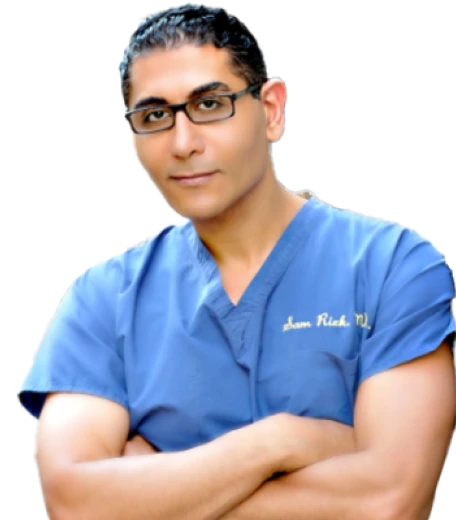


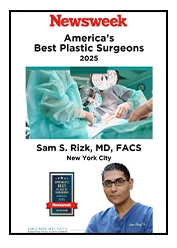
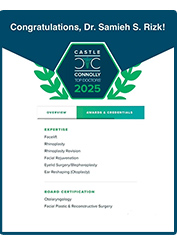
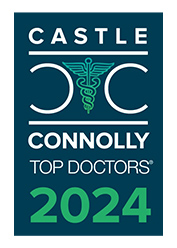

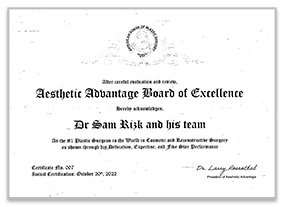
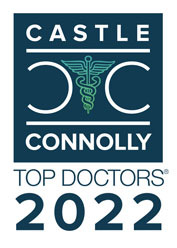

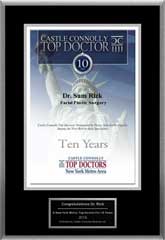
2.jpg)
